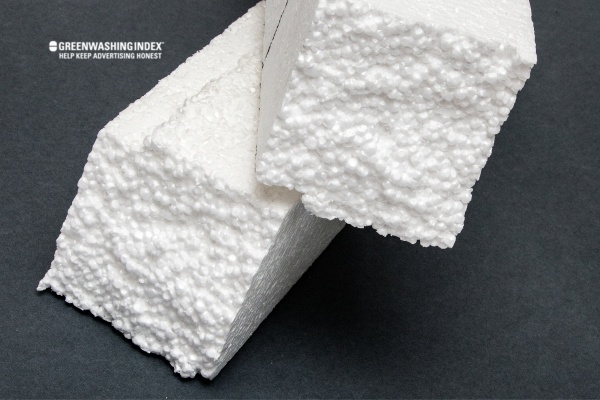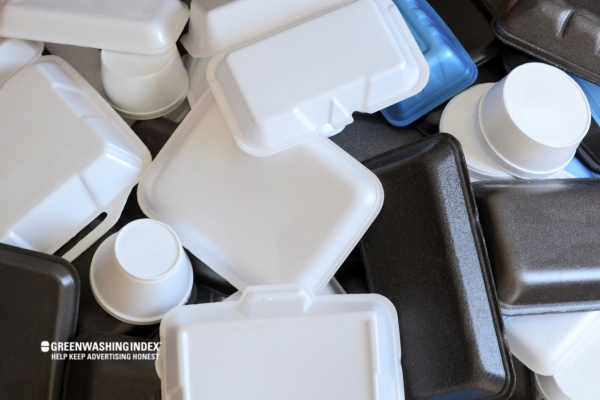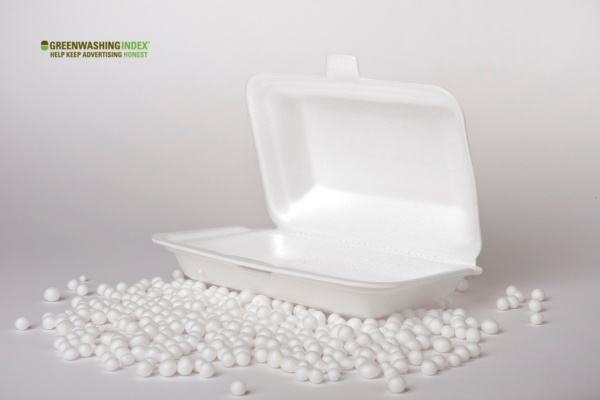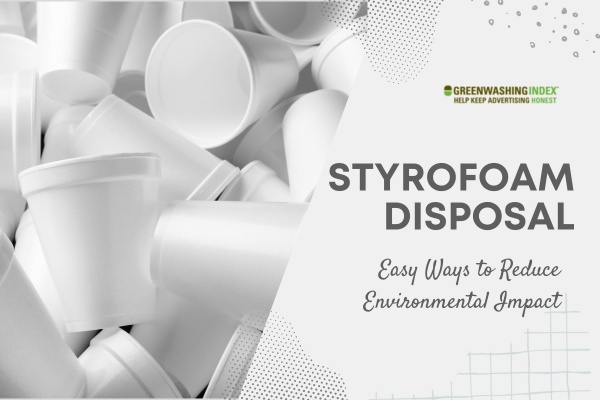Picture this: you’ve just unpacked a new gadget, and you’re left staring at a pile of white, puffy Styrofoam. Where does it all go? If we don’t dispose of Styrofoam properly, it can hurt our planet big time! But don’t stress—stick with me, and you’ll be a Styrofoam disposal pro in no time. Together, we can keep our streets clean and green!
To get rid of Styrofoam the right way:
- Check if your local area recycles Styrofoam.
- If recycling is unavailable, see if there’s a special drop-off spot for it.
- Clean the Styrofoam before tossing it – make sure there’s no food or drink leftovers!
- Try to squish down the big pieces so they don’t take up so much room.
- Think about reusing that puffy stuff for craft projects or packing materials.
What You Will Learn Here
- No-fuss tips on sorting out recyclables from trashy-Styrofoam
- Clever cleaning tricks before recycling
- Smart packing hacks to fit more in that blue bin
- Where to find special bins if your home bin isn’t right
- Reimagining old Styrofoam into cool new things
Typical use for Styrofoam in daily life
Every day, lots of us use Styrofoam without even thinking about it. Here’s where you might see it:
- Packing material: When you buy something fragile, it often comes packed in Styrofoam to keep it safe.
- Cups and plates: Those white cups that keep your coffee hot? That’s usually made of Styrofoam.
- Food containers: Takeaway boxes from restaurants are often made from this material because it’s good for keeping food warm.
But here’s the thing: when those cups, plates, or packing materials get thrown out and not properly disposed of, they can harm the Earth.
The environmental impact of improper Styrofoam disposal
When I talk about improper Styrofoam disposal, I mean just putting it in the trash without caring what happens to it next. This careless action has some serious downsides:
- It doesn’t break down easily: Unlike an apple core that rots away after a short time, Styrofoam can last for hundreds of years with hardly any change.
- Water pollution: Bits of Styrofoam can end up in rivers or oceans and look like food to fish, but eating this isn’t good for them at all.
- Toxic chemicals: As time goes by, chemicals that are bad news for health can seep out into soil and water.
Disposing of Styrofoam correctly means we’re all helping to cut down on these problems. By doing our part with Styrofoam disposal, recycling, or just picking something different instead of this foam stuff when we buy things, we’re taking care of our big home – the Earth!
A Comprehensive Guide for Appropriate ‘Styrofoam Disposal’
Styrofoam, that white, puffy stuff a lot of our take-out food comes in or those big blocks that protect new electronics, is quite tricky to get rid of the right way. But don’t worry; I’m here to guide you through how to sort, clean, and pack your Styrofoam for disposal.

1. Sorting Your ‘Styrofoam’ Correctly
First things first: not all Styrofoam is the same, so we need to sort it out properly. Recyclable Styrofoam usually has a triangle with a number six inside it. This is the kind you can often recycle. On the other hand, if you don’t see this symbol or there’s another number there — chances are it can’t be recycled easily.
Here’s a simple step: look for the triangle symbol on each piece of your Styrofoam before deciding its next stop – recycle bin or trash can.
2. Cleaning Up Before Disposal
Before you toss your clean, recyclable Styrofoam into the bin, make sure it’s really clean. Leftover food and drink can spoil whole batches of recycling! Rinse any bits off your Styrofoam containers with water – just a quick wash will do.
Imagine this: every tiny piece of leftover on that pizza tray could mess up the recycling process! Taking an extra minute to rinse stuff off makes a huge difference.
3. “Pack It Right” – Tips for Efficient ‘Styrofoam Disposal’
Now, let’s talk about packing those pieces properly because space counts when it comes to recycling bins! You want to break down large pieces into smaller ones, but be gentle – don’t make more mess or send little bits flying all over.
To pack efficiently: fit smaller parts into bigger ones like nesting dolls; this way, your Styrofoam block becomes compact and ready for its journey!
And remember, folks, while these steps help with ‘Styrofoam disposal,’ finding eco-friendly alternatives is even better for our planet in the long run!
The Challenge with Styrofoam Disposal
Styrofoam is a name many of us use for products made from polystyrene foam. This material is light and can keep things hot or cold, making it popular for storing food and goods. However, getting rid of Styrofoam isn’t easy. Here’s why:

First off, Styrofoam doesn’t break down naturally like some other materials. When I toss an apple core in my backyard, over time, it turns into part of the soil. But if I throw out a Styrofoam cup out there, it would still be a cup years later.
Now, here’s another issue: most recycling centers won’t take Styrofoam. Recycling involves breaking items down to make something new. With Styrofoam, that process is tough because the material is more air than plastic—about 90% air! So, the cost to transport and recycle it can be more than what the recycled product is worth.
One more challenge with putting Styrofoam in the recycling bin is that it could get mixed up with other recyclable stuff like paper or glass and contaminate those materials. That’s bad because then those items might not be recycled either.
Most people don’t know that there are different types of this foam – some have colors or food stains on them, which makes recycling even harder.
Lastly, let’s talk about what happens when we just chuck Styrofoam in the usual trash can: It ends up taking up a lot of room at landfill sites because it’s mostly air and doesn’t compact well, which could make Styrofoam waste reduction all more challenging.
Because tossing out Styrofoam isn’t great for our planet (really bad, actually), finding smart ways to handle Styrofoam disposal becomes crucial. We should think about either recycling it correctly (Styrofoam recycling) or finding uses for it around our homes (Styrofoam reuse). Better yet, consider alternatives that are kinder to Earth (eco-friendly alternatives to Styrofoam), so we have less to get rid of in the first place!
Remembering these struggles with getting rid of this material might just encourage us all to cut back on using it as much as we can (upcycling) and seek better options whenever possible.
Alternatives to Sending ‘Styrofoam’ to Landfill
Styrofoam is a tricky thing to get rid of in an eco-friendly way. Since it can last a very long time without breaking down, finding better ways than just throwing it away is important. Here’s how you can keep it out of the landfill.
Utilizing Drop-off Programs
When I think about getting rid of Styrofoam, I know throwing it in my trash bin isn’t the best choice. Sending Styrofoam to a landfill is bad for the environment because it doesn’t break down well. But there’s good news! Many communities have special drop-off programs for Styrofoam disposal. Let me share how you can take advantage of these programs.
First things first, find out if there’s a drop-off spot near you. Some places have recycling centers or collection events for Styrofoam upcycling and recycling. Usually, you can check online on your city or town’s official website or give them a call.
Once you find a place, make sure the Styrofoam is clean and free from food bits or stickers – they want it nice and pure. Then, sort it if required; sometimes, they’ll ask that different types of Styrofoam be kept separate.
Then, taking your sorted and clean Styrofoam to the drop-off point is all it takes. They’ll handle the rest! It’s a great feeling knowing you’re helping reduce Styrofoam waste instead of adding to it!
Remember that not all types of Styrofoam may be accepted—some might only take packing materials, while others accept food containers, too. Always check what’s accepted before you go!
Mailing Programs
Another cool way to deal with Styrofoam disposal that not many people know about is mail-back programs. Some companies actually let you send used Styrofoam back to them so they can recycle or reuse it themselves.
Here’s how these mailing programs work:
Look up companies that offer this kind of service – they might be manufacturers who use lots of packaging or specialized recyclers who focus on products like Eco-friendly alternatives to Styrofoam.
Contact them either via their website or over the phone—some may even list instructions online for how their program works specifically.
They’ll usually tell ya what types of Styrofoam items they take back—these could be things like foam packing blocks from shipped goods.
Some will provide shipping labels for free, while others might ask for a small fee—this helps cover their recycling costs (makes sense!).
Package up your clean, sorted-out Styrofoamin stuff according to their directions; don’t forget strong tape so everything stays put during shipping!
Mail off your package at your local post office or another shipping spot—they’ll wing its way back to the company ready for some top-notch Styrofoam recycling!
I encourage folks to always look into these mailing options since not everyone has access to nearby drop-off points – plus, it’s helping create less trash by making sure our foamy friend gets another chance at life!
Legislative Aspects Surrounding ‘Styrofoam Disposal’
When it comes to the rules about Styrofoam disposal, different places have different laws. The reason for these laws is simple: Styrofoam, or polystyrene foam, is not good for our environment. It’s tough to break down, and it can stick around for a very long time, hurting nature.

In some parts of the world, governments have made certain laws that say how you should throw away Styrofoam. They might say you can’t just put it in your normal trash because when Styrofoam ends up in landfills, it takes up space and doesn’t mix back into the earth well. These laws are here to make sure people handle Styrofoam waste in a way that’s less harmful.
Recycling is one method mentioned by laws that helps take care of this material without damaging the planet as much. But not all recycling centers can handle Styrofoam, so these same laws often encourage factories and businesses to stop using Styrofoam altogether.
If you’re unsure about the do’s and don’ts of throwing away Styrofoam where you live, check with your local government or environmental agency. They’ll tell you what you need to do according to the law.
Engaging with Your Community on Post-Styrene Products Handling
Getting rid of Styrofoam becomes easier when everyone in your community works together. There might be some things I can do with my neighbors or local groups to better handle this kind of waste.
For starters, organizing a community recycling day could be a chance for us all to learn more about proper Styrofoam disposal. We could invite experts who know a lot about recycling and upcycling—which means making old things into new useful things—to teach us what we can do.
Some communities set up special drop-off spots for items like Styrofoam so they get taken care of the right way rather than ending up as litter or in regular garbage bins where they may cause harm.
It also helps if we talk to each other about buying less Styrofoam. We could share ideas on eco-friendly alternatives instead—products made from stuff that doesn’t hurt our planet as much when thrown away or recycled. Using fewer products that create bad waste starts with making smart choices at stores and pushing those businesses to offer better options.
Check out the local rules on disposing of Styrofoam (that’s Styrofoam disposal) so I don’t break them by accident. Also, think about joining hands with my community to reduce the use of this material (by looking into Styrofoam reuse and upcycling), recycle more wisely, and encourage others around me. And lastly, remember there are always greener choices over using Styrofoam (Eco-friendly alternatives). Choosing those helps our Earth bit by bit.
FAQs
Is it better to burn Styrofoam or throw it away?
It’s not good to burn Styrofoam since it can release harmful chemicals. It’s better to throw it away properly or find ways to recycle or reuse it.
Is Styrofoam a hazardous waste?
Styrofoam isn’t classified as hazardous waste, but it can still harm the environment if not disposed of correctly.
Does Styrofoam go in the plastic bin?
No, Styrofoam usually shouldn’t go in the plastic bin because many recycling programs don’t accept it. Check your local guidelines for proper Styrofoam disposal.
Conclusion
I’ve armed you with the knowledge to tackle Styrofoam disposal the right way. There’s no denying that getting rid of Styrofoam is tricky, but it’s a necessary step if we’re going to reduce its environmental footprint.
Remember that the effort you make in properly disposing of Styrofoam is not just for yourself but for our planet, too. By choosing to recycle, reuse, or seek eco-friendly alternatives, every piece of Styrofoam saved from the landfill is a win for the environment.
Key Takeaway Points
- Identify and sort Styrofoam before disposal.
- Clean it before recycling to avoid contamination.
- Use community drop-off or mail-back programs whenever available.
- Explore eco-friendly alternatives and encourage legislation for better handling of post-styrene products.



